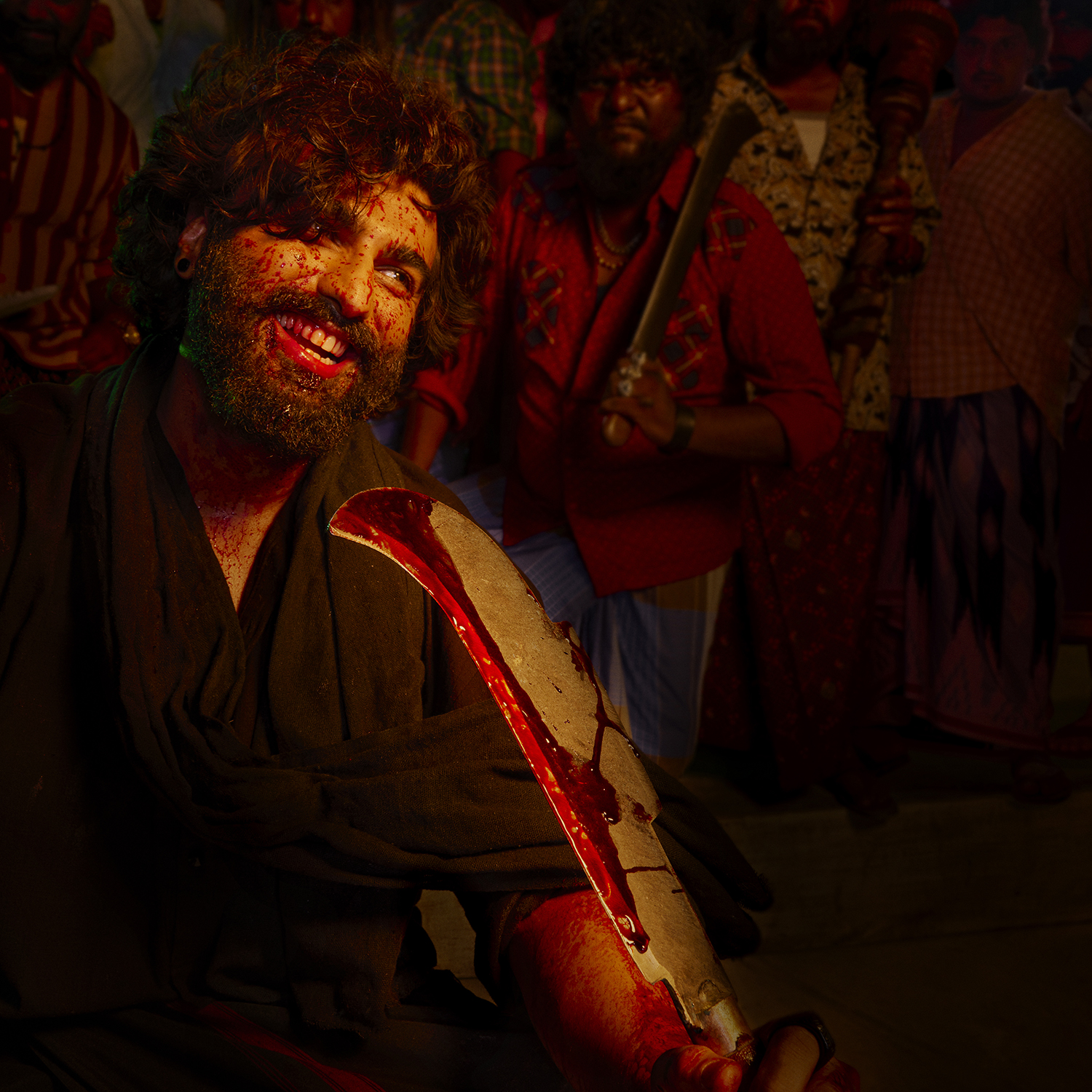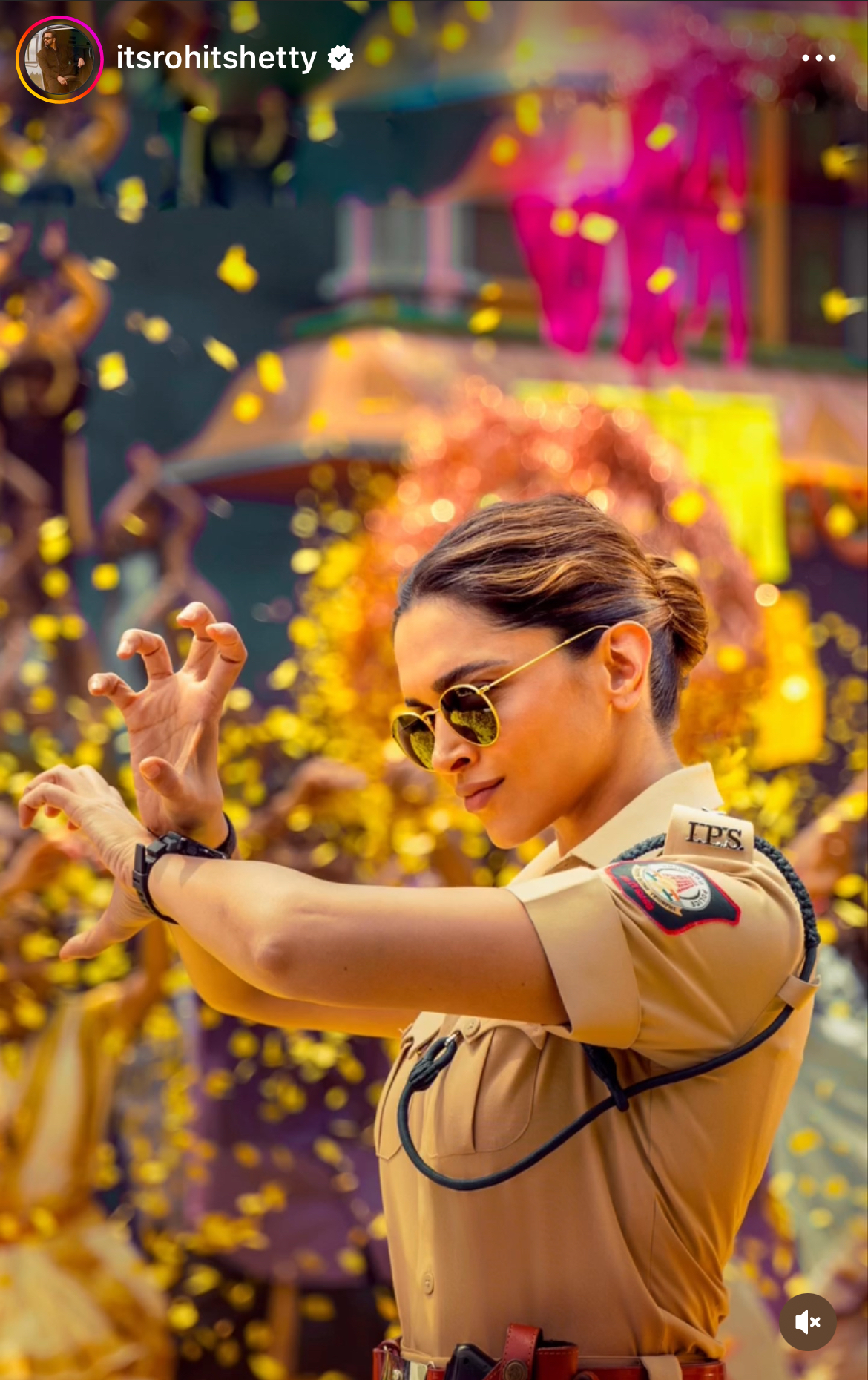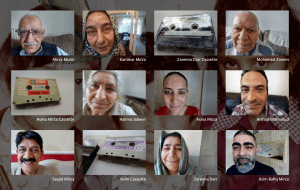
Hindu Heroes and Muslim Demons: How Singham Again Retells the Ramayana in Troubling Ways

Singham Again, the latest installment in Rohit Shetty’s Cop Universe, opens with breathtaking shots of Kashmir’s sprawling mountains and pristine lakes—the new posting of the titular protagonist, police deputy commissioner Bajirao Singham (Ajay Devgn). But the film quickly draws our attention away from Kashmir’s natural beauty to a violent encounter between Singham and the Muslim terrorist Omar Hafiz (Jackie Shroff), one of the main villains of the 2021 Sooryavanshi, the previous film in Shetty’s Cop Universe that has been criticized for its blatant Islamophobia.
After initiating a shoot-out with Singham and his forces, Omar tries to escape on a motorcycle. Still, he is quickly captured by Singham, who viciously beats him up as the Shiva Tandava Stotra—a popular hymn in praise of the Hindu god Shiva—plays in the background.
This scene, from its politics and tonality to its celebration of hypermasculinity, is typical of Shetty’s Cop Universe, which began in 2011 with Singham and has since expanded to include several new police officers, all of whom embody similar heroism and disregard for standard police procedures. Most of the Hindi movies in Shetty’s Cop Universe are retellings of earlier South Indian films in Malayalam, Tamil, and Telugu. Singham Again, however, is a retelling of the story of Rama, the exiled prince of Ayodhya and incarnation of the Hindu deity Vishnu, who journeys alongside his younger brother Lakshmana, and divine monkey companion Hanuman, to rescue his beloved wife Sita from the mighty demon king Ravana.
Although the oldest rendering of Rama’s story is Valmiki’s Sanskrit Ramayana (c. 400 BCE–400 CE), there have been many Ramayanas in the forms of plays, performance traditions, novels, short stories, comics, television shows, and more by Hindus, Jains, Buddhists, Sikhs, Christians, Muslims, Dalits, and Adivasis. Yet Singham Again retells the Ramayana in very concerning and dangerous ways, especially when we consider how the Hindu Right has politicized Rama’s story in recent Indian history.
The Ram Janmabhoomi campaign was a Hindu nationalist movement in the 1980s and early 1990s that claimed that the Babri Masjid, a 16th-century mosque named after the first Mughal emperor Babur, had been built by first razing a Hindu temple in Ayodhya in Uttar Pradesh that marked Rama’s janmabhoomi or “birthplace.” On December 6, 1992, proponents of the Ram Janmabhoomi movement destroyed the Babri Masjid and communal riots erupted across India during which more than 2000 people were killed. The ideologies of the Ram Janmabhoomi movement are deeply embedded in Singham Again.

Hindu Heroes and Muslim Demons in Singham Again
The film’s plot focuses on Singham’s journey to save his wife Avni (Kareena Kapoor Khan) from Omar’s drug lord grandson Zubair, known as “Danger Lanka” (Arjun Kapoor). Although Avni was a hair stylist in Shetty’s 2014 Singham Returns, she is now the organizer of an elaborate nine-day-long Ramlila performance sponsored by the Cultural Ministry of India. Throughout Singham Again, tableaus of Avni’s Ramlila production are juxtaposed with scenes from the adventures of Singham and his A-Team, known as the “Shiva Squad.” For example, right before the goofy yet strong policeman, Sangram “Simmba” Bhalerao (Ranveer Singh), arrives at Colombo Airport in Sri Lanka, we see a shot of Hanuman kneeling before Sita in Ravana’s kingdom of Lanka.
In Singham Again, Singham is Rama, Avni is Sita, and Simmba is Hanuman. Satya Bali (Tiger Shroff), an orphaned South Indian policeman and Kalaripayattu expert who idolizes Singham, is Lakshmana. Daya (Dayanand Shetty), Singham’s loyal policeman friend, is Jatayu, the divine vulture who tries to save Sita from Ravana. Veer “Soorya” Sooryavanshi (Akshay Kumar), an anti-terrorism police officer with a penchant for making dramatic entrances via helicopter, is Garuda, the celestial eagle mount of Vishnu. Singham Again also introduces the kickass South Indian female cop, Shakti Shetty (Deepika Padukone) AKA “Lady Singham.” As her name suggests, Shakti strongly resembles the powerful Hindu warrior goddess Durga.
All these main “good” characters in Singham Again are dominant-caste Hindus. The Maharashtrian Brahmin Singham makes a point of emphasizing his identity as a “true Maratha” and he angrily announces that while he “respects Mahatma Gandhi,” he “worships Chhatrapati Shivaji Maharaj,” the 17th-century Maratha ruler known for opposing the Mughal emperor Aurangzeb. In India today, Aurangzeb is remembered as a tyrannical Muslim leader who persecuted Hindus, while Shivaji has become an icon of Hindu nationalism. Singham’s worship of Shivaji presents this film’s modern Rama as a militant protector of Hindus from dangerous Muslims.

The Ravana of Singham Again is Zubair, a terrifying beast who easily and gleefully slaughters fifteen policemen in Madurai with a machete. One Tamilian man who is forced to work for Zubair in Madurai describes the drug lord to Singham as a shaitan or “devil.” Ironically, in the film’s climax when Singham fights Zubair one-on-one, we once again hear the Shiva Tandava Stotra, a hymn attributed to Ravana. Although Simmba remarks that Zubair is not interested in jihad (which by the way, does not mean “holy war”), the fact that this Ravana is Muslim is quite alarming.
In many authoritative Hindu Ramayanas, including Valmiki’s Sanskrit epic, Ravana is a ten-headed demon king. During the Ram Janmabhoomi campaign, Babur was described as the Mughal version of Ravana and as the common ancestor of India’s Muslims. By depicting Ravana as a Muslim, Singham Again—like the Ram Janmabhoomi movement—not only vilifies Muslims but literally “demonizes” them. This representation is a major departure from Shetty’s Singham Returns from 2014, in which Singham takes down a treacherous Hindu godman/politician, and Singham, Avni, and several police officers pray alongside Muslims in the Mahim Dargah, a Sufi shrine in Mumbai.
It is also very troubling that most of Zubair’s Sri Lankan henchmen are giant dark-skinned men with handlebar mustaches, who are eerily similar to the evil Kalakeya people in S.S. Rajamouli’s Bahubali films and the Tamilian goons in Shetty’s 2013 Chennai Express. Sri Lanka’s Ramayana traditions are richly complex, but very little of them are shown in the film. Although Singham Again transports us across South Asia—from the luscious greenery of Kashmir, to the bustling city of Mumbai, to the towering temples of Madurai and Rameswaram, to the ports of Colombo—this movie does not reflect the remarkable diversity of the many Ramayanas of South Asia. Instead, Singham Again clearly presents certain South Asian communities as Rama’s enemies.

The Ramayana as Indian History in Singham Again
“Of course! It’s a fact!” Avni responds (in English) after her and Singham’s teenage son, Shaurya (Viren Vazirani), expresses disbelief that Rama traveled 3000 kilometers to rescue Sita. During her Ramlila production, Avni repeatedly emphasizes that Valmiki’s Ramayana is not a kahani (story) but history. She also describes Ayodhya as Rama’s janmabhoomi.
In the trailer for Singham Again, we hear Singham proclaim: “In India (Bharat), there has been a tradition (pratha) that whenever the abduction of Mother Sita has happened, then Lanka has burned. The repetition of history (itihas) is about to happen.”
When Singham travels to Sri Lanka (the country many South Asians believe to be the actual location of Ravana’s kingdom of Lanka), he prays at the Seetha Amman temple in Nuwara Eliya, a shrine to Sita that is primarily visited by Indian Hindu tourists rather than Sinhala or Tamil Sri Lankans. At this temple, Singham is shown a giant depression in the ground that is said to be Hanuman’s footprint.
Shetty himself has stated that Singham Again’s “locations are all places where the incidents [of the Ramayana] have happened. Many of us know the story but not the actual location where it happened” (emphasis added).
Singham Again therefore presents the events of Valmiki’s Ramayana as historical facts rather than mythological stories. This is very much in line with the message of the Ram Janmabhoomi campaign. Interestingly, Singham Again is not the only recent movie to depict this epic as history. The historicity of the Sanskrit Ramayana is at the center of Abhishek Sharma’s 2022 Ram Setu, a film about an atheist archeologist who explores the existence of Adam’s Bridge/Ram Setu, the bridge Rama’s monkey allies build to Lanka in Valmiki’s Ramayana.
However, what makes Singham Again different from Ram Setu and earlier Ramayana films is that this is the first movie inspired by the story of Rama to be released in India after the inauguration of the Ram Janmabhoomi Mandir in Ayodhya on January 22nd of this year. After years of legal battles, in 2019, the Supreme Court granted permission for the construction of a Hindu Rama temple on the site of the demolition of the Babri Masjid. The partially-constructed Ram Janmabhoomi Mandir was inaugurated in Ayodhya in a lavish ceremony attended by several Bollywood celebrities, including Shetty.

During the week of the temple’s consecration, Muslims all over India were subjected to communal violence in Rama’s name. It is disappointing—though not surprising—that Singham Again is perpetuating the central claim of the Ram Janmabhoomi campaign about the historicity of the Sanskrit Ramayana, given how this claim is continuing to harm India’s Muslims over thirty years after the Babri Masjid’s destruction.
How Singham Again Evokes Ramanand Sagar’s Hindi Ramayan TV Show
The visuals of Avni’s Ramlila production in Singham Again are strikingly similar to those in Ramanand Sagar’s Hindi Ramayan TV show, one of the most popular Ramayanas in modern India that first aired on Doordarshan in the late 1980s. In April 2020, when the serial was rebroadcast during the COVID-19 pandemic, it was viewed by 77 million people, supposedly becoming the most-watched TV show globally.
For many Hindus, Sagar’s Ramayan is the ultimate visual Ramayana. When the trailer of Om Raut’s Hindi/Telegu Ramayana film Adipurush premiered in 2022, several angry viewers complained about how the characters in this movie looked nothing like their counterparts in the television Ramayan. The saffron robes that Rama and Lakshmana wear in Singham Again’s Ramlila, however, immediately bring to mind Rama and Lakshmana’s costumes in Sagar’s Ramayan. In fact, Shubham Sharma (the Ramlila Rama actor in Singham Again) posted a photo of himself and Vanshu Pannu (the Ramlila Lakshmana actor) in their costumes above a screenshot of Rama and Lakshmana in Sagar’s Ramayan on Instagram.

There is no doubt that the Ramlila sequences in Singham Again are meant to evoke Sagar’s television Ramayan. This is significant because the immense popularity of Sagar’s Ramayan had a profound impact on the Ram Janmabhoomi campaign in the late 1980s and early 1990s. At political rallies during the Ram Janmabhoomi movement, volunteers dressed up as Rama and Lakshmana from the television show, and the theme song of Sagar’s Ramayan was blasted from loudspeakers.
More recently, Sagar’s Ramayan has been used to promote the inauguration of the new Ram Janmabhoomi Mandir. This January, the actors who played Rama, Sita, and Lakshmana in Sagar’s TV show appeared in a music video for Sonu Nigam’s 2024 devotional song, “Hamare Ram Aaye Hai” (“Our Rama Has Arrived”), in which they joyfully walk through the streets of Ayodhya, home of the newly consecrated Ram Janmabhoomi Mandir—and just happen to stop a menacing bearded man dressed in black from abducting a married Hindu woman.
Shetty’s film is thus the latest Ramayana retelling to utilize the iconic imagery of Sagar’s popular television Ramayan to present a very specific version of Rama’s story.
Singham Again is a cinematic Ramayana that distinctly depicts Indian caste-privileged Hindus as heroes and Muslims—and Sri Lankans—as villains. At the inauguration of the Ram Janmabhoomi Mandir in January, politicians described the temple as a national symbol for all Indians. The history of the Ram Janmabhoomi campaign and the demolition of the Babri Masjid, however, has made it abundantly clear that this temple is not for all Indians. Unfortunately, it is apparent that Singham Again is a Ramayana that is not for all Indians or all South Asians either.
Singham Again, the latest installment in Rohit Shetty’s Cop Universe, opens with breathtaking shots of Kashmir’s sprawling mountains and pristine lakes—the new posting of the titular protagonist, police deputy commissioner Bajirao Singham (Ajay Devgn). But the film quickly draws our attention away from Kashmir’s natural beauty to a violent encounter between Singham and the Muslim terrorist Omar Hafiz (Jackie Shroff), one of the main villains of the 2021 Sooryavanshi, the previous film in Shetty’s Cop Universe that has been criticized for its blatant Islamophobia.
After initiating a shoot-out with Singham and his forces, Omar tries to escape on a motorcycle. Still, he is quickly captured by Singham, who viciously beats him up as the Shiva Tandava Stotra—a popular hymn in praise of the Hindu god Shiva—plays in the background.
This scene, from its politics and tonality to its celebration of hypermasculinity, is typical of Shetty’s Cop Universe, which began in 2011 with Singham and has since expanded to include several new police officers, all of whom embody similar heroism and disregard for standard police procedures. Most of the Hindi movies in Shetty’s Cop Universe are retellings of earlier South Indian films in Malayalam, Tamil, and Telugu. Singham Again, however, is a retelling of the story of Rama, the exiled prince of Ayodhya and incarnation of the Hindu deity Vishnu, who journeys alongside his younger brother Lakshmana, and divine monkey companion Hanuman, to rescue his beloved wife Sita from the mighty demon king Ravana.
Although the oldest rendering of Rama’s story is Valmiki’s Sanskrit Ramayana (c. 400 BCE–400 CE), there have been many Ramayanas in the forms of plays, performance traditions, novels, short stories, comics, television shows, and more by Hindus, Jains, Buddhists, Sikhs, Christians, Muslims, Dalits, and Adivasis. Yet Singham Again retells the Ramayana in very concerning and dangerous ways, especially when we consider how the Hindu Right has politicized Rama’s story in recent Indian history.
The Ram Janmabhoomi campaign was a Hindu nationalist movement in the 1980s and early 1990s that claimed that the Babri Masjid, a 16th-century mosque named after the first Mughal emperor Babur, had been built by first razing a Hindu temple in Ayodhya in Uttar Pradesh that marked Rama’s janmabhoomi or “birthplace.” On December 6, 1992, proponents of the Ram Janmabhoomi movement destroyed the Babri Masjid and communal riots erupted across India during which more than 2000 people were killed. The ideologies of the Ram Janmabhoomi movement are deeply embedded in Singham Again.

Hindu Heroes and Muslim Demons in Singham Again
The film’s plot focuses on Singham’s journey to save his wife Avni (Kareena Kapoor Khan) from Omar’s drug lord grandson Zubair, known as “Danger Lanka” (Arjun Kapoor). Although Avni was a hair stylist in Shetty’s 2014 Singham Returns, she is now the organizer of an elaborate nine-day-long Ramlila performance sponsored by the Cultural Ministry of India. Throughout Singham Again, tableaus of Avni’s Ramlila production are juxtaposed with scenes from the adventures of Singham and his A-Team, known as the “Shiva Squad.” For example, right before the goofy yet strong policeman, Sangram “Simmba” Bhalerao (Ranveer Singh), arrives at Colombo Airport in Sri Lanka, we see a shot of Hanuman kneeling before Sita in Ravana’s kingdom of Lanka.
In Singham Again, Singham is Rama, Avni is Sita, and Simmba is Hanuman. Satya Bali (Tiger Shroff), an orphaned South Indian policeman and Kalaripayattu expert who idolizes Singham, is Lakshmana. Daya (Dayanand Shetty), Singham’s loyal policeman friend, is Jatayu, the divine vulture who tries to save Sita from Ravana. Veer “Soorya” Sooryavanshi (Akshay Kumar), an anti-terrorism police officer with a penchant for making dramatic entrances via helicopter, is Garuda, the celestial eagle mount of Vishnu. Singham Again also introduces the kickass South Indian female cop, Shakti Shetty (Deepika Padukone) AKA “Lady Singham.” As her name suggests, Shakti strongly resembles the powerful Hindu warrior goddess Durga.
All these main “good” characters in Singham Again are dominant-caste Hindus. The Maharashtrian Brahmin Singham makes a point of emphasizing his identity as a “true Maratha” and he angrily announces that while he “respects Mahatma Gandhi,” he “worships Chhatrapati Shivaji Maharaj,” the 17th-century Maratha ruler known for opposing the Mughal emperor Aurangzeb. In India today, Aurangzeb is remembered as a tyrannical Muslim leader who persecuted Hindus, while Shivaji has become an icon of Hindu nationalism. Singham’s worship of Shivaji presents this film’s modern Rama as a militant protector of Hindus from dangerous Muslims.

The Ravana of Singham Again is Zubair, a terrifying beast who easily and gleefully slaughters fifteen policemen in Madurai with a machete. One Tamilian man who is forced to work for Zubair in Madurai describes the drug lord to Singham as a shaitan or “devil.” Ironically, in the film’s climax when Singham fights Zubair one-on-one, we once again hear the Shiva Tandava Stotra, a hymn attributed to Ravana. Although Simmba remarks that Zubair is not interested in jihad (which by the way, does not mean “holy war”), the fact that this Ravana is Muslim is quite alarming.
In many authoritative Hindu Ramayanas, including Valmiki’s Sanskrit epic, Ravana is a ten-headed demon king. During the Ram Janmabhoomi campaign, Babur was described as the Mughal version of Ravana and as the common ancestor of India’s Muslims. By depicting Ravana as a Muslim, Singham Again—like the Ram Janmabhoomi movement—not only vilifies Muslims but literally “demonizes” them. This representation is a major departure from Shetty’s Singham Returns from 2014, in which Singham takes down a treacherous Hindu godman/politician, and Singham, Avni, and several police officers pray alongside Muslims in the Mahim Dargah, a Sufi shrine in Mumbai.
It is also very troubling that most of Zubair’s Sri Lankan henchmen are giant dark-skinned men with handlebar mustaches, who are eerily similar to the evil Kalakeya people in S.S. Rajamouli’s Bahubali films and the Tamilian goons in Shetty’s 2013 Chennai Express. Sri Lanka’s Ramayana traditions are richly complex, but very little of them are shown in the film. Although Singham Again transports us across South Asia—from the luscious greenery of Kashmir, to the bustling city of Mumbai, to the towering temples of Madurai and Rameswaram, to the ports of Colombo—this movie does not reflect the remarkable diversity of the many Ramayanas of South Asia. Instead, Singham Again clearly presents certain South Asian communities as Rama’s enemies.

The Ramayana as Indian History in Singham Again
“Of course! It’s a fact!” Avni responds (in English) after her and Singham’s teenage son, Shaurya (Viren Vazirani), expresses disbelief that Rama traveled 3000 kilometers to rescue Sita. During her Ramlila production, Avni repeatedly emphasizes that Valmiki’s Ramayana is not a kahani (story) but history. She also describes Ayodhya as Rama’s janmabhoomi.
In the trailer for Singham Again, we hear Singham proclaim: “In India (Bharat), there has been a tradition (pratha) that whenever the abduction of Mother Sita has happened, then Lanka has burned. The repetition of history (itihas) is about to happen.”
When Singham travels to Sri Lanka (the country many South Asians believe to be the actual location of Ravana’s kingdom of Lanka), he prays at the Seetha Amman temple in Nuwara Eliya, a shrine to Sita that is primarily visited by Indian Hindu tourists rather than Sinhala or Tamil Sri Lankans. At this temple, Singham is shown a giant depression in the ground that is said to be Hanuman’s footprint.
Shetty himself has stated that Singham Again’s “locations are all places where the incidents [of the Ramayana] have happened. Many of us know the story but not the actual location where it happened” (emphasis added).
Singham Again therefore presents the events of Valmiki’s Ramayana as historical facts rather than mythological stories. This is very much in line with the message of the Ram Janmabhoomi campaign. Interestingly, Singham Again is not the only recent movie to depict this epic as history. The historicity of the Sanskrit Ramayana is at the center of Abhishek Sharma’s 2022 Ram Setu, a film about an atheist archeologist who explores the existence of Adam’s Bridge/Ram Setu, the bridge Rama’s monkey allies build to Lanka in Valmiki’s Ramayana.
However, what makes Singham Again different from Ram Setu and earlier Ramayana films is that this is the first movie inspired by the story of Rama to be released in India after the inauguration of the Ram Janmabhoomi Mandir in Ayodhya on January 22nd of this year. After years of legal battles, in 2019, the Supreme Court granted permission for the construction of a Hindu Rama temple on the site of the demolition of the Babri Masjid. The partially-constructed Ram Janmabhoomi Mandir was inaugurated in Ayodhya in a lavish ceremony attended by several Bollywood celebrities, including Shetty.

During the week of the temple’s consecration, Muslims all over India were subjected to communal violence in Rama’s name. It is disappointing—though not surprising—that Singham Again is perpetuating the central claim of the Ram Janmabhoomi campaign about the historicity of the Sanskrit Ramayana, given how this claim is continuing to harm India’s Muslims over thirty years after the Babri Masjid’s destruction.
How Singham Again Evokes Ramanand Sagar’s Hindi Ramayan TV Show
The visuals of Avni’s Ramlila production in Singham Again are strikingly similar to those in Ramanand Sagar’s Hindi Ramayan TV show, one of the most popular Ramayanas in modern India that first aired on Doordarshan in the late 1980s. In April 2020, when the serial was rebroadcast during the COVID-19 pandemic, it was viewed by 77 million people, supposedly becoming the most-watched TV show globally.
For many Hindus, Sagar’s Ramayan is the ultimate visual Ramayana. When the trailer of Om Raut’s Hindi/Telegu Ramayana film Adipurush premiered in 2022, several angry viewers complained about how the characters in this movie looked nothing like their counterparts in the television Ramayan. The saffron robes that Rama and Lakshmana wear in Singham Again’s Ramlila, however, immediately bring to mind Rama and Lakshmana’s costumes in Sagar’s Ramayan. In fact, Shubham Sharma (the Ramlila Rama actor in Singham Again) posted a photo of himself and Vanshu Pannu (the Ramlila Lakshmana actor) in their costumes above a screenshot of Rama and Lakshmana in Sagar’s Ramayan on Instagram.

There is no doubt that the Ramlila sequences in Singham Again are meant to evoke Sagar’s television Ramayan. This is significant because the immense popularity of Sagar’s Ramayan had a profound impact on the Ram Janmabhoomi campaign in the late 1980s and early 1990s. At political rallies during the Ram Janmabhoomi movement, volunteers dressed up as Rama and Lakshmana from the television show, and the theme song of Sagar’s Ramayan was blasted from loudspeakers.
More recently, Sagar’s Ramayan has been used to promote the inauguration of the new Ram Janmabhoomi Mandir. This January, the actors who played Rama, Sita, and Lakshmana in Sagar’s TV show appeared in a music video for Sonu Nigam’s 2024 devotional song, “Hamare Ram Aaye Hai” (“Our Rama Has Arrived”), in which they joyfully walk through the streets of Ayodhya, home of the newly consecrated Ram Janmabhoomi Mandir—and just happen to stop a menacing bearded man dressed in black from abducting a married Hindu woman.
Shetty’s film is thus the latest Ramayana retelling to utilize the iconic imagery of Sagar’s popular television Ramayan to present a very specific version of Rama’s story.
Singham Again is a cinematic Ramayana that distinctly depicts Indian caste-privileged Hindus as heroes and Muslims—and Sri Lankans—as villains. At the inauguration of the Ram Janmabhoomi Mandir in January, politicians described the temple as a national symbol for all Indians. The history of the Ram Janmabhoomi campaign and the demolition of the Babri Masjid, however, has made it abundantly clear that this temple is not for all Indians. Unfortunately, it is apparent that Singham Again is a Ramayana that is not for all Indians or all South Asians either.
SUPPORT US
We like bringing the stories that don’t get told to you. For that, we need your support. However small, we would appreciate it.







